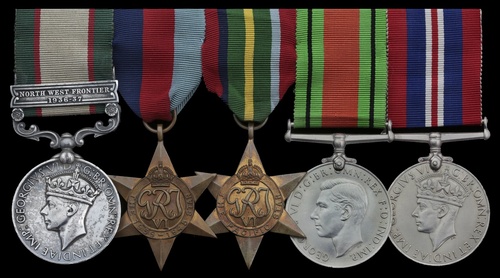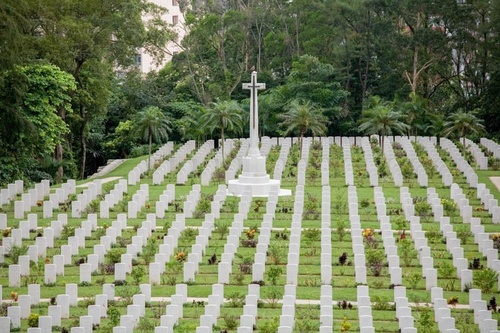Auction: 22002 - Orders, Decorations and Medals
Lot: 95
'By 21.00 [on 18 December 1941] however, the Japanese have landed their first wave, estimated at 7,500 men. They overwhelm the initial defences they encounter, by-passing any significant points of resistance in their race to get to high ground, and approach Wong Nai Chung Gap. At this time it is not generally realized that the Japanese have invaded. John Whitehead of the Royal Artillery for example, driving a Morris lorry to Braemar Point comes under such heavy fire that, with three Indian soldiers on board, he gingerly heads back to Causeway Bay. At North Point, he is surprised to see stationary vehicles littering the road, and it is not until the Indian sitting next to him is shot in the chest that he realizes the Japanese are on the Island. Abandoning the vehicle, he sees it hit by a mortar or grenade, killing the other two Indians. The battle for Hong Kong has started in earnest … '
Not the Slightest Chance - The Defence of Hong Kong, 1941, by Tony Sheldon, refers.
A poignant pre-war North-West Frontier operations and Second World War campaign group of five awarded to Sepoy Bakhshi Ram, 2-14th Punjabis, who was mortally wounded in the defence of Hong Kong on 18 December 1941
India General Service 1936-39, 1 clasp, North-West Frontier 1936-37 (10961 Sepoy Bakhshi Ram, 2-14 Punjab R.); 1939-45 Star; Pacific Star; Defence and War Medals 1939-45, the first with edge nicks, otherwise very fine and better (5)
Bakhshi Ram was born about 1915, the son of Ganu and Chunju Ram; on his death in Hong Kong in December 1941, he left a widow, Koshaliya, who was a resident at the hamlet of Seokar, near Barsar, in the district of Kangra, in northern India.
The 2-14th Punjabis, commanded by Lieutenant-Colonel Gerald Kidd, first saw action in the New Territories, and undertook a fighting retreat to Tsim Sha Tsui, where they were evacuated to the island of Hong Kong aboard the famous Star Ferry.
Subsequently reformed as part of Brigadier J. K. Lawson's West Brigade, the Battalion was heavily engaged in the chaotic and gallant actions fought after the Japanese invasion of the island. It suffered a loss of 55 killed in action or died of wounds, in addition to 69 being recorded as 'missing' and a further 160 wounded.
Bakhshi Ram may have received his mortal wounds at 1100 hours on the 18 December, when a 500-pound bomb hit his battalion's H.Q. in Garden Road, killing 24 of his comrades and wounding another 36. As touched upon in the above quote, however, the Punjabis were also present in actions in the Wong Nai Chung Gap, so he may have received his wounds there.
However, one source suggests he was among six Punjabis who became casualties on Shouson Hill; see Not the Slightest Chance - The Defence of Hong Kong, 1941, by Tony Sheldon.
Either way, Bakhshi Ram died of his wounds at the Indian General Hospital on the 20 December. He was 26 years old at the time of his death, has no known grave and is commemorated on the Sai Wan Memorial, Hong Kong.
The memorial stands in a Commonwealth War Graves cemetery, which is in the north-east of Hong Kong, about ten kilometres from the centre of Victoria. At the entrance to the cemetery on Cape Collinson Road, the memorial stands to the memory of some 2,000 military personnel who died in Hong Kong - or in captivity - and who have no known grave.
Subject to 20% VAT on Buyer’s Premium. For more information please view Terms and Conditions for Buyers.
Sold for
£450
Starting price
£140







